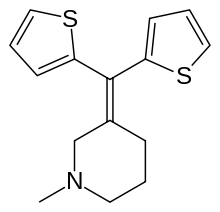Tipepidine
Tipepidine (INN) (brand names Asverin, Antupex, Asvelik, Asvex, Bitiodin, Cofdenin A, Hustel, Nodal, Sotal), also known as tipepidine hibenzate (JAN), is a synthetic, non-opioid antitussive and expectorant of the thiambutene class.[1][2] It acts as an inhibitor of G protein-coupled inwardly-rectifying potassium channels (GIRKs).[3] The drug was discovered in the 1950s,[4] and was developed in Japan in 1959.[5] It is used as the hibenzate and citrate salts.[1][5]
 | |
| Clinical data | |
|---|---|
| AHFS/Drugs.com | International Drug Names |
| Routes of administration | Oral |
| ATC code | |
| Legal status | |
| Legal status |
|
| Identifiers | |
IUPAC name
| |
| CAS Number | |
| PubChem CID | |
| ChemSpider | |
| UNII | |
| KEGG | |
| CompTox Dashboard (EPA) | |
| Chemical and physical data | |
| Formula | C15H17NS2 |
| Molar mass | 275.434 g/mol g·mol−1 |
| 3D model (JSmol) | |
SMILES
| |
InChI
| |
| (verify) | |
The usual dose is 20 mg every 4–6 hours. Possible side effects of tipepidine, especially in overdose, may include drowsiness, vertigo, delirium, disorientation, loss of consciousness, and confusion.[5]
Tipepidine has recently garnered interest as a potential psychiatric drug. It is being investigated in depression,[3][6][7] obsessive-compulsive disorder,[8] and attention-deficit hyperactivity disorder (ADHD).[9][10][11] Through inhibition of GIRK channels, tipepidine increases dopamine levels in the nucleus accumbens, but without increasing locomotor activity or producing methamphetamine-like behavioral sensitization, and this action appears to be at least partly responsible for its antidepressant-like effects in rodents.[12][13]
References
- C.R. Ganellin; David J. Triggle (21 November 1996). Dictionary of Pharmacological Agents. CRC Press. pp. 1988–. ISBN 978-0-412-46630-4.
- Index Nominum 2000: International Drug Directory. Taylor & Francis. January 2000. pp. 1649–. ISBN 978-3-88763-075-1.
- Kawaura, Kazuaki; Ogata, Yukino; Inoue, Masako; Honda, Sokichi; Soeda, Fumio; Shirasaki, Tetsuya; Takahama, Kazuo (2009). "The centrally acting non-narcotic antitussive tipepidine produces antidepressant-like effect in the forced swimming test in rats". Behavioural Brain Research. 205 (1): 315–318. doi:10.1016/j.bbr.2009.07.004. ISSN 0166-4328.
- ES Patent 272195
- Imai, Yuki; Ishii, Wakako; Endo, Ayumi; Arakawa, Chikako; Kohira, Ryutaro; Fujita, Yukihiko; Fuchigami, Tatsuo; Mugishima, Hideo (2011). "Tipepidine hibenzate intoxication". Pediatrics International. 53 (5): 779–781. doi:10.1111/j.1442-200X.2010.03297.x. ISSN 1328-8067.
- KAWAURA, Kazuaki; HONDA, Sokichi; SOEDA, Fumio; SHIRASAKI, Tetsuya; TAKAHAMA, Kazuo (2010). "A Novel Antidepressant-like Action of Drugs Possessing GIRK Channel Blocking Action in Rats". Yakugaku Zasshi. 130 (5): 699–705. doi:10.1248/yakushi.130.699. ISSN 0031-6903.
- Sasaki T, Hashimoto K, Tachibana M, Kurata T, Kimura H, Komatsu H, Ishikawa M, Hasegawa T, Shiina A, Hashimoto T, Kanahara N, Shiraishi T, Iyo M (2014). "Tipepidine in adolescent patients with depression: a 4 week, open-label, preliminary study". Neuropsychiatr Dis Treat. 10: 719–22. doi:10.2147/NDT.S63075. PMC 4015794. PMID 24833905.
- Honda, Sokichi; Kawaura, Kazuaki; Soeda, Fumio; Shirasaki, Tetsuya; Takahama, Kazuo (2011). "The potent inhibitory effect of tipepidine on marble-burying behavior in mice". Behavioural Brain Research. 216 (1): 308–312. doi:10.1016/j.bbr.2010.08.010. ISSN 0166-4328. PMID 20713091.
- Sasaki T, Hashimoto K, Tachibana M, Kurata T, Okawada K, Ishikawa M, Kimura H, Komatsu H, Ishikawa M, Hasegawa T, Shiina A, Hashimoto T, Kanahara N, Shiraishi T, Iyo M (2014). "Tipepidine in children with attention deficit/hyperactivity disorder: a 4-week, open-label, preliminary study". Neuropsychiatr Dis Treat. 10: 147–51. doi:10.2147/NDT.S58480. PMC 3908907. PMID 24493927.
- Hashimoto, K.; Sasaki, T. (2014). "Old drug tipepidine as new hope for children with ADHD". Australian & New Zealand Journal of Psychiatry. 49 (2): 181–182. doi:10.1177/0004867414553952. ISSN 0004-8674.
- Dehbozorghi, S.; Bagheri, S.; Moradi, K.; Shokraee, K.; Mohammadi, M-R.; Akhondzadeh, S. (2019). "Efficacy and safety of tipepidine as adjunctive therapy in children with attention‐deficit/hyperactivity disorder: Randomized, double‐blind, placebo‐controlled clinical trial". Psychiatry and Clinical Neurosciences. 73 (11): 690–696. doi:10.1111/pcn.12913. ISSN 0912-2036.
- Hamasaki R, Shirasaki T, Soeda F, Takahama K (2013). "Tipepidine activates VTA dopamine neuron via inhibiting dopamine D₂ receptor-mediated inward rectifying K⁺ current". Neuroscience. 252: 24–34. doi:10.1016/j.neuroscience.2013.07.044. PMID 23896570.
- Hamao K, Kawaura K, Soeda F, Hamasaki R, Shirasaki T, Takahama K (2015). "Tipepidine increases dopamine level in the nucleus accumbens without methamphetamine-like behavioral sensitization". Behav. Brain Res. 284: 118–24. doi:10.1016/j.bbr.2015.02.012. PMID 25687844.